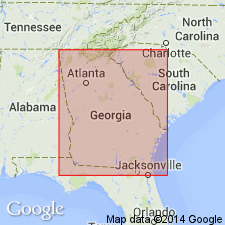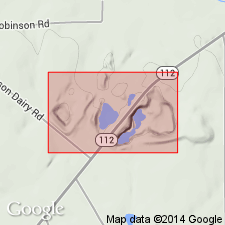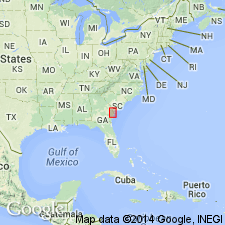
- Usage in publication:
-
- Bridgeboro Limestone
- Modifications:
-
- First used
- Dominant lithology:
-
- Limestone
- AAPG geologic province:
-
- South Georgia sedimentary province
Summary:
Name Bridgeboro Limestone is introduced for certain strata formerly mapped as Suwannee Limestone and Flint River Formation in FL and GA. Subdivided into lower Ellaville Limestone Member and Suwannacoochee Dolomite Member. Underlies Suwannee Limestone and overlies Ocala Group. Age is Oligocene.
Source: GNU records (USGS DDS-6; Reston GNULEX).

- Usage in publication:
-
- Bridgeboro Limestone
- Modifications:
-
- Biostratigraphic dating
- Overview
- Areal extent
- AAPG geologic province:
-
- South Georgia sedimentary province
Summary:
Bridgeboro Limestone is a rhodolith limestone that occurs on the northern and southern flanks of the Gulf Trough and crops out discontinuously in a NE-SW band from south-central GA to northwest FL, a distance of 290 km. Assignment of the Bridgeboro Limestone to the Vicksburgian Stage (lower Oligocene) is substantiated by the occurrence of the bivalves CHLAMYS (ANATIPOPECTEN) ANATIPES (Morton) and C. (LYROPECTEN) DUNCANENSIS Mansfield, the bryozoan TUBUCELLARIA VICKSBURGICA Canu and Bassler, and an assemblage of larger Foraminifera dominated by LEPIDOCYCLINA (EULEPIDINA) UNDOSA Cushman and L. (NEPHROLEPIDINA) YURNAGUNENSIS Cushman. On the basis of larger Foraminifera, macroinvertebrates, and physical stratigraphic relationships, authors propose that the Bridgeboro Limestone (GA,FL), Duncan Church beds (FL), and Glendon Limestone (AL,MS) are biostratigraphically and lithostratigraphically correlative. Duncan Church beds in Washington Co., FL, are here included in the Bridgeboro.
Source: GNU records (USGS DDS-6; Reston GNULEX).

- Usage in publication:
-
- Bridgeboro Limestone
- Modifications:
-
- Named
- Dominant lithology:
-
- Limestone
- AAPG geologic province:
-
- South Georgia sedimentary province
Summary:
Bridgeboro Limestone, formally named in this report, is a rhodolithic limestone that occurs in two disconnected bands on the flanks of the Gulf Trough in the central and southwestern Georgia Coastal Plain. The northern band extends from Dublin in Laurens Co., southwestward to at least Decatur Co. and grades laterally into the Florala Limestone Member, which extends into AL and FL. The southern belt occurs in Thomas, Brooks, and Colquitt Cos. and grades laterally southeastward into the Ellaville Limestone and Suwannacoochee Dolostone (both new). Strata were formerly included in the Flint River Formation, Suwannee Limestone, and Vicksburg Group. The Duncan Church beds of western FL are included in the Bridgeboro Limestone of this report. Type section is designated in Mitchell Co., GA. The lime pit at Duncan Church, northeastern Washington Co., FL, is designated as a reference section. The interval 8 ft to 40 ft in a core taken at a site near the lime pit and interval 174 ft to 226 ft in a core from the Hunt 1 (W-10954) are designated parastratotypes of the Bridgeboro in FL. This is the southernmost known occurrence of the unit. The Bridgeboro is distinguished by its abundance of rhodoliths in a matrix of variably bioclastic calcarenite. The rhodoliths range from less than 0.5 in. to 5.0 in. The matrix consists of a fairly uniform, even-textured, granular calcarenite made up of very fine- to medium-grained bioclastic debris. Unit is at least 65 ft ( 20 m) thick at the type locality. Measured thicknesses in ten cores range from 25.5 ft to 92.5 ft. Disconformably overlies the Ocala Limestone at the type section and gradationally overlies the Marianna Limestone elsewhere. Underlies residuum at the type section and elsewhere disconformably underlies the Chattahoochee Formation or the Suwannee Limestone. Age of the Bridgeboro is early Oligocene (Vicksburgian, Rupelian) based on macrofossils.
Source: GNU records (USGS DDS-6; Reston GNULEX).
For more information, please contact Nancy Stamm, Geologic Names Committee Secretary.
Asterisk (*) indicates published by U.S. Geological Survey authors.
"No current usage" (†) implies that a name has been abandoned or has fallen into disuse. Former usage and, if known, replacement name given in parentheses ( ).
Slash (/) indicates name conflicts with nomenclatural guidelines (CSN, 1933; ACSN, 1961, 1970; NACSN, 1983, 2005, 2021). May be explained within brackets ([ ]).

